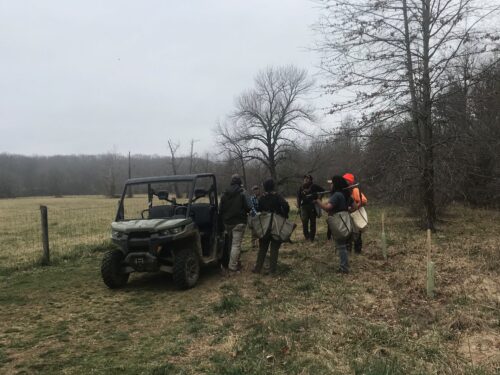Field Notes: Buffer Benefits for River and Trail
April 15, 2021 9:40 am

By Deya Ramsden, DOF Middle James River Forest Watershed Project Coordinator
A newly expanded riparian forest buffer in Nelson County is not only protecting the Rockfish River, but also enhancing wildlife habitat and beautifying a local trail.
Last winter, Rockfish Valley Foundation President Peter Agelasto met with Virginia Department of Forestry (DOF) staff to discuss improving the Rockfish Valley Trail. His idea was to expand the existing buffer, to better shade the river and protect it from sediment and pollutants, while also diversifying the plant species composition within the buffer. James River Buffer Program Coordinator Deya Ramsden, and area foresters Martha Warring and B.J. Butler, worked together to create a plan that included planting 570 native shrubs and trees, managing invasive species, and recommending future maintenance. The project was funded through the James River Buffer Program, with matching funds from the Virginia Trees for Clean Program.


Conservation Services Incorporated (CSI) was contracted to install and maintain the planting. On March 23, CSI planted seedlings, complete with tree shelters, in a 1 ¾-acre area along the trail. The shrub species were chosen for multiple reasons: flowers that attract pollinators, fruits or seeds for birds, ability to form colonies from the roots and thus discourage invasive species, and ability to thrive in the partial shade of a forest understory. The species planted were buttonbush, hazel-alder, red osier and silky dogwoods, false indigo and southern arrowwood. The tree species selected included persimmon, pawpaw, and red mulberry, which have fruits favored by wildlife (and people); sycamore, river birch, and yellow-poplar, which are fast growing pioneer species that frequently colonize streambanks; redbud, with early spring flowers valued by people and pollinators; and pin oak, a long-lived, slow grower that adapts well to wet conditions.
The shelters, or “tubes,” installed by CSI protect the one-year-old seedlings from trampling, deer browse, and vole damage, and they aid in maintenance. The shelters provide a favorable growing environment, free from wind and drastic temperature changes, giving the seedlings time to focus on getting tall. Shelters are removed once the tree extends three inches out of the top of the tube. DOF recommends using bird netting to cover the top of tree tubes to prevent songbirds from entering and becoming trapped in the tubes. Tree planters should leave a quarter-sized opening in the net for the tree shoot to emerge and remove the nets when the tree begins emerging from the tube to prevent the stem from becoming entangled as it grows.
 Tree shelters protect new seedlings.
Tree shelters protect new seedlings.CSI will return in late spring to apply herbicide, in order to reduce weed competition around the seedlings and target invasive species along the trail. The first three years is a crucial time period for young seedlings, and maintenance is required to allow seedlings to gain growth and outcompete the weeds. Not many people realize that fescue, the most common pasture grass, is a non-native, aggressive species that competes with seedlings for moisture and nutrients. If grass is not controlled around the seedlings, the buffer may not survive at a level that results in a future forest. During planting, a small area is scalped to remove the grass, but follow-up maintenance with herbicide, mowing or weed-whacking is needed to control grass as the seedlings get established. Foresters will inspect the buffer annually to assess its progress and adjust maintenance requirements over the next three years.

Future plans for the trail include addressing areas where compaction is causing concentrated flow of sediment to reach the river. Several best management practices (BMPs) can mitigate these conditions, including temporarily blocking some access points to give them time to “rest.” In the meantime, consider a visit to the lovely Rockfish Valley, where you can walk the trail and envision those young trees grown into a future forest.
About the James River Buffer Program
The James River Buffer Program began in 2019 and is funded through a grant from the Virginia Environmental Endowment. The program is carried out through partnering organizations, DOF and the James River Association (JRA), who draw on their expertise and community connections to help landowners install buffers. The program is turn-key, not a cost-share, offering installation of seedlings, materials, and three years of follow-up maintenance and guidance at no cost. This flexible program is open to any landowner in need of a buffer. Through DOF, rural, residential, commercial, and county or city owned lands are eligible for enrollment, while JRA focuses on rural lands with the highest priority of buffer need. The application process is simple. Learn more and request a consultation, or reach out to your local DOF forester for more information.
About the Virginia Trees for Clean Water Program (VTCW)
DOF’s Virginia Trees for Clean Water (VTCW) program is funded by the USDA Forest Service Chesapeake Bay Watershed Forestry Program, Virginia Water Quality Improvement Fund, and Department of Environmental Quality’s Chesapeake Bay Regulatory and Accountability Program. VTCW is designed to improve water quality across the Commonwealth through on-the-ground efforts to plant trees where they are needed most. Goals are to expand tree canopy, positively impact water quality, increase energy conservation practices, advance community health, and grow recreation and educational opportunities. VTCW provides matching funds to the James River Buffer Program for projects that meet the program criteria. In a typical year, the program awards grants of up to $14,000 per proposal, with an aim of a 50/50 match for the project. Contact Lara Johnson for more information.
Tags: Partnerships, Riparian Forest Buffers, Tree Planting
Category: Water Quality
